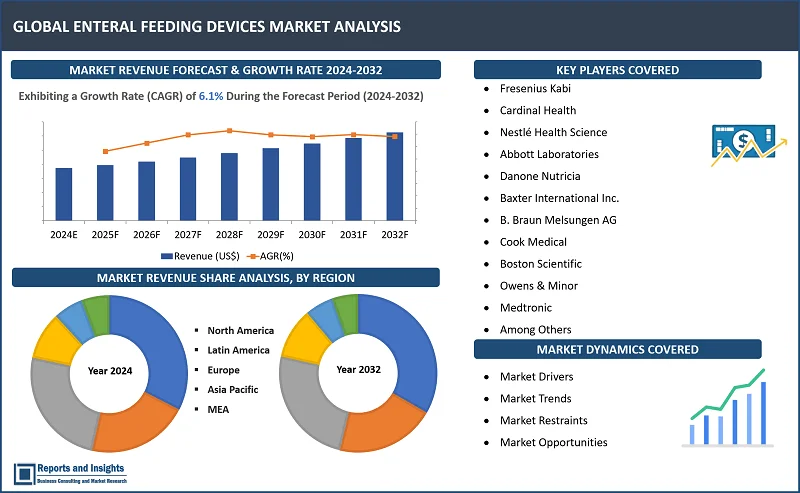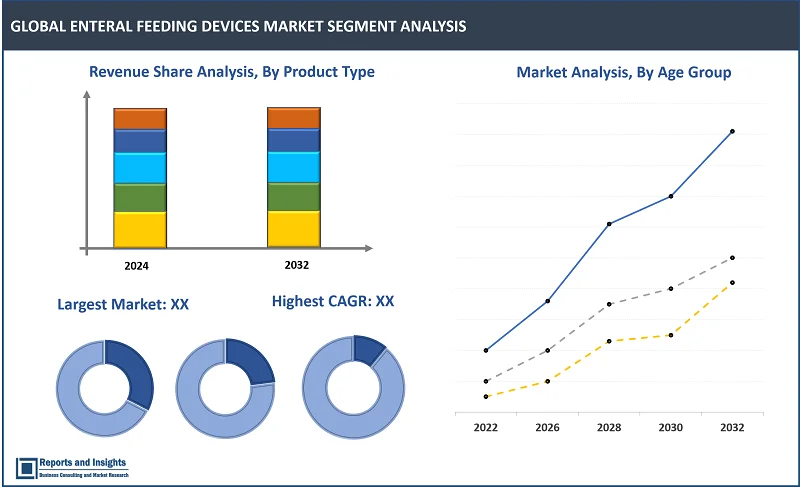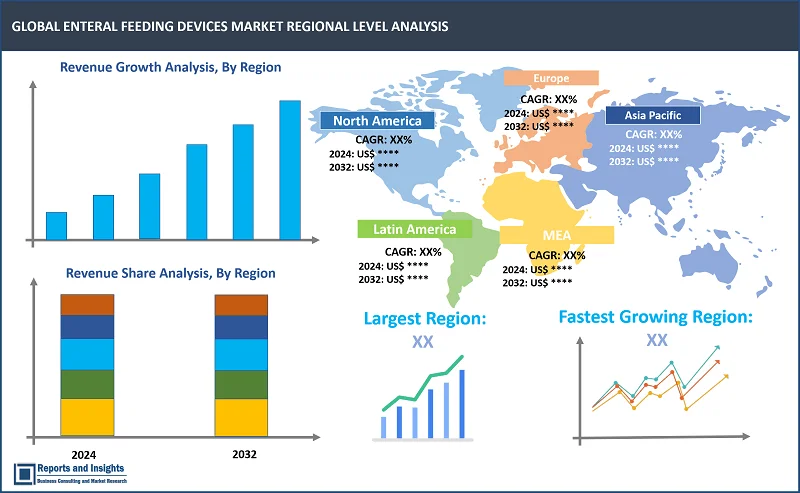Market Overview:
"The enteral feeding devices market was valued at US$ 4.1 Billion in 2023 and is expected to register a CAGR of 6.1% over the forecast period and reach US$ 7.0 Billion in 2032."
|
Report Attributes |
Details |
|
Base Year |
2023 |
|
Forecast Years |
2024-2032 |
|
Historical Years |
2021-2023 |
|
Enteral Feeding Devices Market Growth Rate (2024-2032) |
6.1% |
Enteral access feeding is a procedure or process to provide nutrients via a feeding tube inserted into the nose, mouth, stomach, or small intestine, and into the Gastrointestinal (GI) tract for those patients or individuals who are unable to consume food orally, or with conditions such as dysphagia, gastrointestinal disorders, or neurological impairments, and are unable to absorb sufficient nutrients to sustain adequate nutrition and hydration. This is a lifesaving modality to prevent or treat depleted nutrient state that could lead to tissue breakdown, compromised immune function, and poor wound healing in patients. Malnutrition and dehydration is known to cause adverse effects on psychological well-being and trigger feelings of apathy, depression, fatigue, and loss of morale, all of which can have negative impact on a patient’s ability for adequate self-care.
Various devices, such as feeding tubes, syringes, pumps, and accessories, are currently used to deliver liquid nutrition, fluids, and medications through the nose, mouth, stomach or small intestine directly to the GI tract, with some of the larger-bore devices being used for gastric decompression and drainage. These devices not only support patient recovery, but also improve quality of life, and are used in hospitals, long-term care facilities, and in home care settings, and support needs of pediatric and geriatric patient populations.
Materials such as silicone and polyurethane are most widely used to manufacture these products as these are safe for human use and are resistant to degradation. Technological advancements in enteral feeding devices include development of smart feeding pumps that offer precise control and monitoring capabilities, use of antimicrobial materials to minimize risks of infection, and others.
Demand for these devices and products is primarily driven by rising prevalence of chronic disease and conditions, premature birth rates, aging population, and increasing preference for these for supporting patient needs in home care settings. Another trend supporting market growth is rapid developments in personalized nutrition and remote monitoring solutions, especially in some developed countries.

Enteral Feeding Devices Market Trends and Drivers:
Rising prevalence of chronic conditions such as cancer, neurological disorders, and gastrointestinal diseases, necessitating long-term nutritional support, is a major factor driving demand for enteral feeding devices. This is further supported by a rapidly increasing elderly population and rising prevalence of age-related diseases and medical conditions, who are highly likely to require enteral feeding.
Also, technological advancements such as smart pumps with enhanced control and monitoring capabilities, use of antimicrobial materials, and further innovations in these products are contributing significantly to rising consumer preference and user satisfaction. Innovations such as tube positioning systems to improve patient safety and reduce complications and easier access to home care services are other factors supporting growth of the market. In addition, regulatory support and favorable healthcare initiatives in some countries and advancements in healthcare facilities and accessibility to care outside traditional clinical environments are supporting market growth.
Enteral Feeding Devices Market Restraining Factors:
A primary factor having a negative impact on market growth is high cost of enteral feeding devices, which can deter wider adoption among healthcare providers and patients. Initial expenses for purchasing devices and ongoing maintenance costs can be high, and this makes the option less accessible for individuals and healthcare facilities with budget constraints. Also, reimbursement policies may not fully cover these expenses in some countries, and this also acts as a restraint to adoption.
Safety risks and complications is another factor that can impact sales and preferences to a major extent. Enteral feeding can pose risks such as aspiration pneumonia, tube displacement, or infections if not properly managed, and such safety concerns may deter healthcare providers and patients from choosing enteral feeding devices, especially in situations where alternative nutrition options exist.
In addition, stringent regulatory requirements for the approval and use of enteral feeding devices can pose challenges for manufacturers and healthcare providers, and navigating complex regulatory processes can delay product launches and increase costs. Research and development challenges is a factor that is proving to be crucial to overcome, and developing advanced enteral feeding devices requires substantial investment in R&D. These challenges are further expanded by need to design devices that are easier to use, safer, and more effective across a range of patient types and medical conditions. The high cost of R&D, coupled with the time-consuming process of bringing new devices to market, may slow down the introduction of innovative products, and this can have a negative impact on potential market growth. Also, emerging technologies such as parenteral nutrition, which can offer alternative solutions for patients requiring nutritional support may divert demand away from enteral feeding devices and impact market growth to some extent.
Furthermore, while enteral feeding is a life-saving intervention for many patients, it is not without drawbacks, and potential disadvantages include the physical discomfort and psychological impact of having a feeding tube, which may lead to reduced patient compliance. Additionally, long-term use of feeding devices can cause issues such as mucosal irritation or dependency on the device, affecting patient well-being.
Enteral Feeding Devices Market Opportunities:
Leading players in the global enteral feeding devices market can explore potential opportunities by adopting lucrative strategies to create additional revenue streams. Manufacturers can invest in the development of smart and connected enteral feeding devices that incorporate Internet of Things (IoT) capabilities for real-time monitoring and data analytics. This can offer healthcare providers and caregivers better oversight of patient nutrition and reduce the risk of complications, as well as gain appeal with more tech-savvy individuals.
Companies can also diversify their product portfolios by offering a range of devices tailored to specific patient populations, such as pediatric or geriatric patients. Customization based on age group and specific medical needs can enhance patient outcomes and increase market share, while enabling better positioning in a dynamic market. Collaborations with healthcare providers and researchers to develop innovative solutions and products that address emerging needs in enteral nutrition, including exploring newer materials, tube designs, and delivery methods to improve patient comfort and safety can present lucrative opportunities.
In addition, companies can expand market reach by focusing on untapped markets, particularly in emerging economies where awareness of enteral nutrition is growing. This can be achieved through strategic partnerships and by gaining local market knowledge to make appropriate moves to establish a strong foothold in such regions. Investing in patient and caregiver education programs can also serve to build trust and create brand loyalty by empowering users to manage enteral feeding procedures more effectively, while resulting in better patient outcomes.
Enteral Feeding Devices Market Segmentation:

By Product Type
- Feeding Tubes
- Enteral Feeding Pumps
- Enteral Syringes
- Giving Sets and Other Accessories
Among the product type segments, the feeding tubes segment is expected to account for the largest revenue share in the enteral feeding devices market. This projection is supported by wide use of these products across various patient populations, including those with cancer, neurological disorders, and gastrointestinal issues. Feeding tubes are versatile, offering multiple methods of delivery and compatibility with various patient needs, and the importance in maintaining adequate nutrition and hydration for patients who cannot consume food orally makes these all the more crucial in enteral feeding.
By Age Group
- Pediatric
- Adult
- Geriatric
Among the age group segments, the adult segment is expected to account for the largest revenue share over the forecast period. This can be attributed to the high prevalence of chronic diseases and conditions such as cancer, neurological disorders, and gastrointestinal diseases in adults, which often require long-term enteral feeding. The adult population also encompasses a broad range of medical needs and health issues, and rapid increase in global aging population and incline in age-related diseases and conditions is expected to continue to drive rising demand for enteral feeding devices and products in future.
By Indication
- Oncology
- Neurology
- Gastroenterology
- Diabetes
- Other Indications
Among the disease indication segments, the oncology segment is expected to account for the largest revenue share over the forecast period. Cancer patients often experience challenges with oral intake due to side effects from treatments such as chemotherapy or radiation therapy, and enteral feeding provides a critical approach to maintaining proper nutrition and hydration during treatment and recovery. As cancer prevalence continues to rise worldwide, the demand for enteral feeding devices for oncology patients is expected to grow significantly, and this is a key factor expected to support the projected revenue increase for this segment.
By End-User
- Hospitals and Clinics
- Home Care Settings
- Ambulatory Surgical Centers
- Long-Term Care Facilities
Among the end user segments, the hospitals and clinics segment is expected to account for the largest revenue share, and this is driven by the high volume of patients receiving medical care in these settings, many of whom require enteral nutrition support due to conditions such as severe illness, surgery, or injury. Hospitals and clinics typically provide specialized and complex care, necessitating the use of advanced enteral feeding devices. Also, high focus on patient safety and the availability of trained healthcare professionals contribute to higher admissions and this is supporting revenue growth of the segment.
By Region

North America
- United States
- Canada
Europe
- Germany
- United Kingdom
- France
- Italy
- Spain
- Russia
- Poland
- Benelux
- Nordic
- Rest of Europe
Asia Pacific
- China
- Japan
- India
- South Korea
- ASEAN
- Australia & New Zealand
- Rest of Asia Pacific
Latin America
- Brazil
- Mexico
- Argentina
Middle East & Africa
- Saudi Arabia
- South Africa
- United Arab Emirates
- Israel
- Rest of MEA
The global enteral feeding devices market is divided into five key regions: North America, Europe, Asia Pacific, Latin America, and the Middle East and Africa. Among these regional markets, North America leads in terms of revenue share, primarily driven by major contribution from the United States (US) owing to presence of a highly developed healthcare infrastructure, high prevalence of chronic diseases such as cancer and diabetes, and high focus on technological advancements in medical devices. Also, a growing healthcare sector in Canada is contributing to incline in revenue share of the North America enteral feeding devices market.
In Europe, countries such as Germany, the United Kingdom (UK), and France are major players in the enteral feeding devices market. Factors such as aging population and increasing prevalence rates of chronic diseases such as cancer and gastrointestinal disorders are drive demand for enteral feeding devices, supported by a strong healthcare system and high awareness of enteral nutrition.
In Asia Pacific, China and Japan lead in terms of demand for enteral feeding devices owing to large and aging populations in these countries, combined with increasing healthcare expenditure and rising awareness of enteral nutrition. Emerging markets such as India and Southeast Asian countries are also registering increasing demand due to improvements in healthcare infrastructure.
Some of the common factors driving overall growth of the enteral feeding devices market include aging population, rising chronic disease prevalence, and technological advancements and innovations in device design, materials, and focus on enhancing patient outcomes and safety.
Leading Companies in Enteral Feeding Devices Market & Competitive Landscape:
The competitive landscape in the global Enteral Feeding Devices Market is dynamic and characterized by significant innovation and strategic collaborations. Leading companies are investing majorly in research and development to create advanced products and maintain a competitive edge. Partnerships with academic institutions and research organizations allow companies to access cutting-edge technologies and expertise. Strategic acquisitions and mergers help companies expand their product portfolios and market presence. In addition, companies are focusing on personalized medicine approaches to tailor treatments to individual patients, enhancing efficacy and patient outcomes. Companies are also leveraging data analytics and artificial intelligence to accelerate drug development and improve treatment precision.
Furthermore, a number of leading players are forming strategic alliances and entering into licensing agreements to gain access to new markets and technologies. By pursuing these strategies, companies can maintain their market position and expand their consumer base in the rapidly evolving nanomedicine industry.
These companies include:
- Fresenius Kabi
- Cardinal Health
- Nestlé Health Science
- Abbott Laboratories
- Danone Nutricia
- Baxter International Inc.
- B. Braun Melsungen AG
- Cook Medical
- Boston Scientific
- Owens & Minor
- Medtronic
- Moog Inc.
- Amsino International
- Vygon Group
- Halyard Health
Recent Developments:
- September 2023: Cardinal Health announced the US debut of its Kangaroo OMNI Enteral Feeding Pump, which is designed to provide enteral feeding patients with more personalized feeding options to support their specific requirements. Kangaroo OMNI is the only enteral feeding system in the US that can operate independently of orientation, delivering thick, homogenized, and blended formulas. Its compact design enhances portability, while its ability to feed, flush, and hydrate, as well as store a 30-day feeding history, makes this pump a versatile solution for meeting the enteral feeding needs of patients and caregivers across different settings, from hospitals to homes. The product also prioritizes caregiver ease of use by featuring a user interface similar to other Kangaroo pumps, enabling seamless transition. Its design is the most water-resistant of the Kangaroo line, capable of enduring cleaning under running water. The pump is also equipped with compatible accessories, including a pole clamp and table stand. Additionally, it supports translation of screen content into 19 languages, enhancing accessibility for users around the world.
- November 2022: Moog introduced a new software update for Infinity and Infinity Orange enteral feeding pumps, featuring an auto prime capability. For over 15 years, the company’s pumps have been essential for pediatric and adult tube-fed patients, enabling them to maintain prescribed feeding schedules and stay active. The new software update simplifies the priming process, allowing users to activate the function with just one button press. Infinity pumps are known for their user-friendliness, portability, and robustness, and according to the company, this update enhances convenience and efficiency.
Enteral Feeding Devices Market Research Scope
|
Report Metric |
Report Details |
|
Enteral Feeding Devices Market size available for the Years |
2021-2023 |
|
Base Year |
2023 |
|
Forecast Period |
2024-2032 |
|
Compound Annual Growth Rate (CAGR) |
6.1% |
|
Segment covered |
Product Type, Age Group, Indication, End-User |
|
Regions Covered |
North America: The U.S. & Canada Latin America: Brazil, Mexico, Argentina, & Rest of Latin America Asia Pacific: China, India, Japan, Australia & New Zealand, ASEAN, & Rest of Asia Pacific Europe: Germany, The U.K., France, Spain, Italy, Russia, Poland, BENELUX, NORDIC, & Rest of Europe The Middle East & Africa: Saudi Arabia, United Arab Emirates, South Africa, Egypt, Israel, and Rest of MEA |
|
Fastest Growing Country in Europe |
UK |
|
Largest Market |
North America |
|
Key Players |
Fresenius Kabi, Cardinal Health, Nestlé Health Science, Abbott Laboratories, Danone Nutricia, Baxter International Inc., B. Braun Melsungen AG, Cook Medical, Boston Scientific, Owens & Minor, Medtronic, Moog Inc., Amsino International, Vygon Group, Halyard Health |
Frequently Asked Question
What is the size of the global enteral feeding devices market in 2023?
The global enteral feeding devices market size reached US$ 4.1 Billion in 2023.
At what CAGR will the global enteral feeding devices market expand?
The global market is expected to register a 6.1% CAGR through 2024-2032.
Who are leaders in the enteral feeding devices market?
Leading companies in the enteral feeding devices market include Fresenius Kabi, Cardinal Health, and Nestlé Health Science. These companies are recognized for their extensive product portfolios, global reach, and commitment to innovation.
What are some key factors driving revenue growth of the enteral feeding devices market?
Some key factors driving revenue growth include aging population, rising prevalence of chronic diseases such as cancer and gastrointestinal disorders, and technological advancements such as smart pumps.
What are some major challenges faced by companies in the enteral feeding devices market?
Some major challenges include regulatory complexities, high R&D costs, and stringent safety standards. Companies also face issues such as reimbursement constraints and potential safety risks such as infection or tube displacement, which may impact patient outcomes and adoption rates.
How is the competitive landscape in the enteral feeding devices market?
Companies focus on innovation and product diversification to gain a competitive edge. Strategic partnerships, acquisitions, and expanding distribution networks are common strategies used to increase market share and strengthen global presence.
How is the Enteral Feeding Devices Market report segmented?
The Enteral Feeding Devices Market report is segmented based on product type, age group, indication, end-user, and region.
Who are the key players in the Enteral Feeding Devices Market report?
Fresenius Kabi, Cardinal Health, Nestlé Health Science, Abbott Laboratories, Danone Nutricia, Baxter International Inc., B. Braun Melsungen AG, Cook Medical, Boston Scientific, Owens & Minor, Medtronic, Moog Inc., Amsino International, Vygon Group, and Halyard Health.

